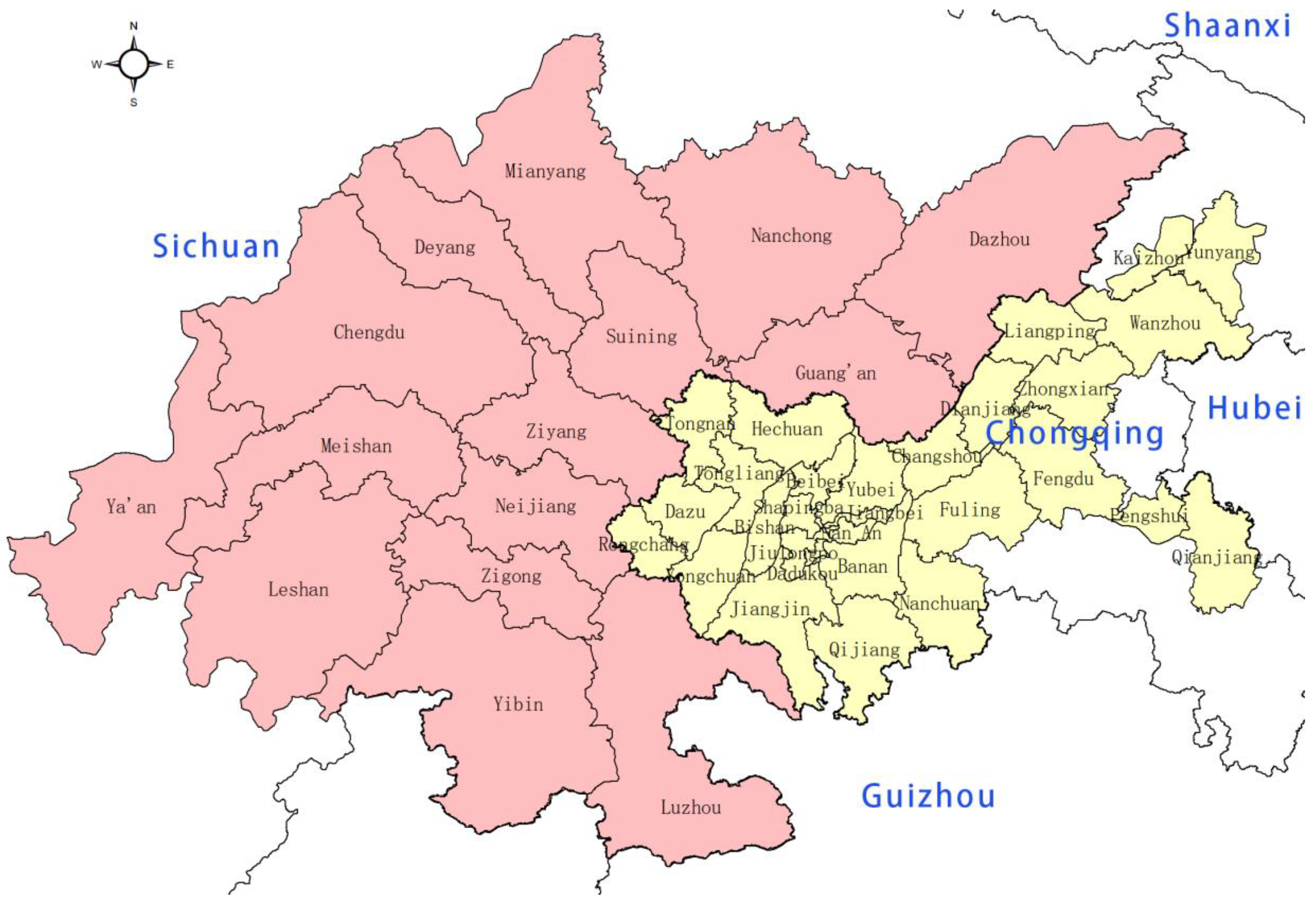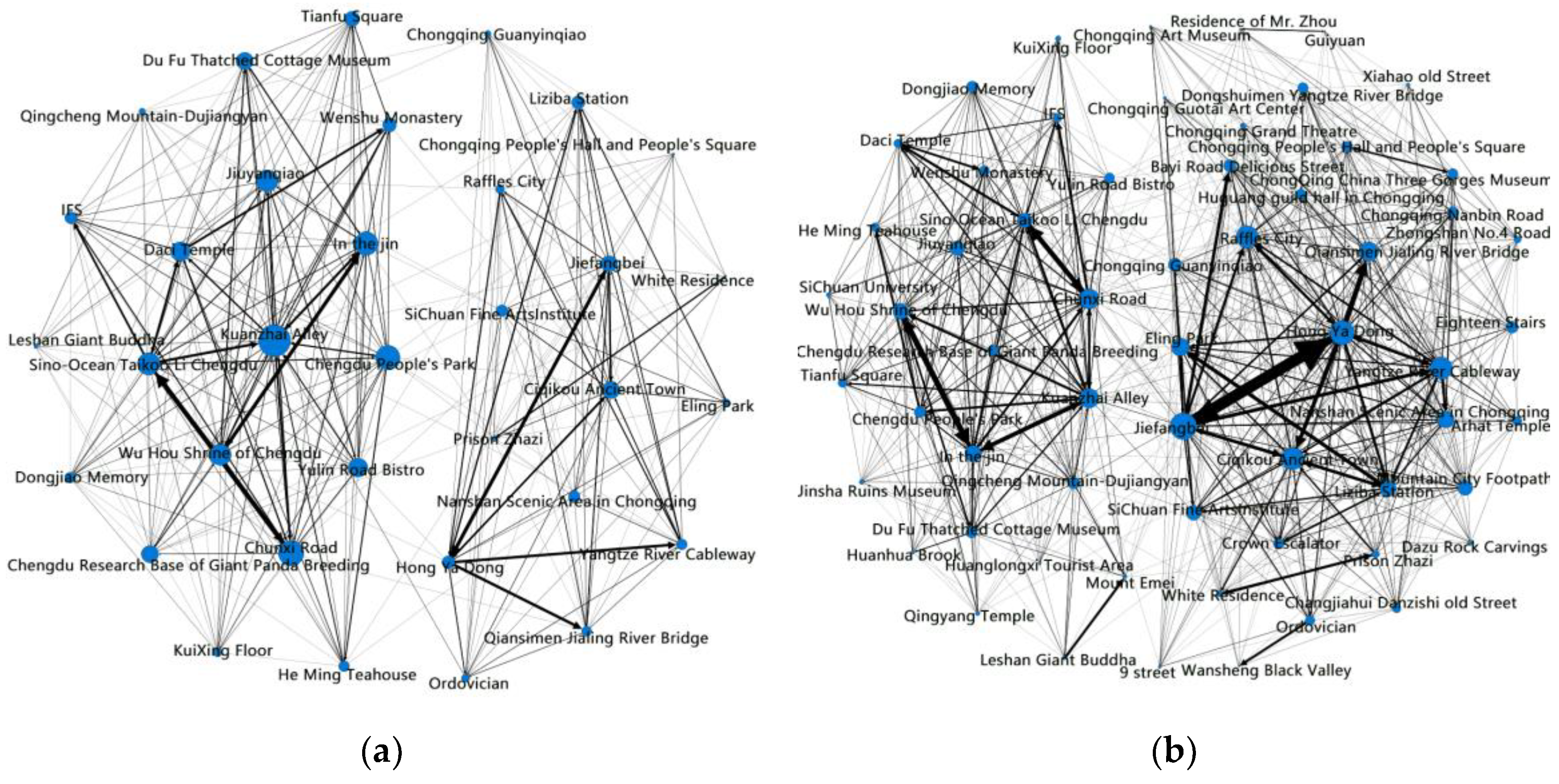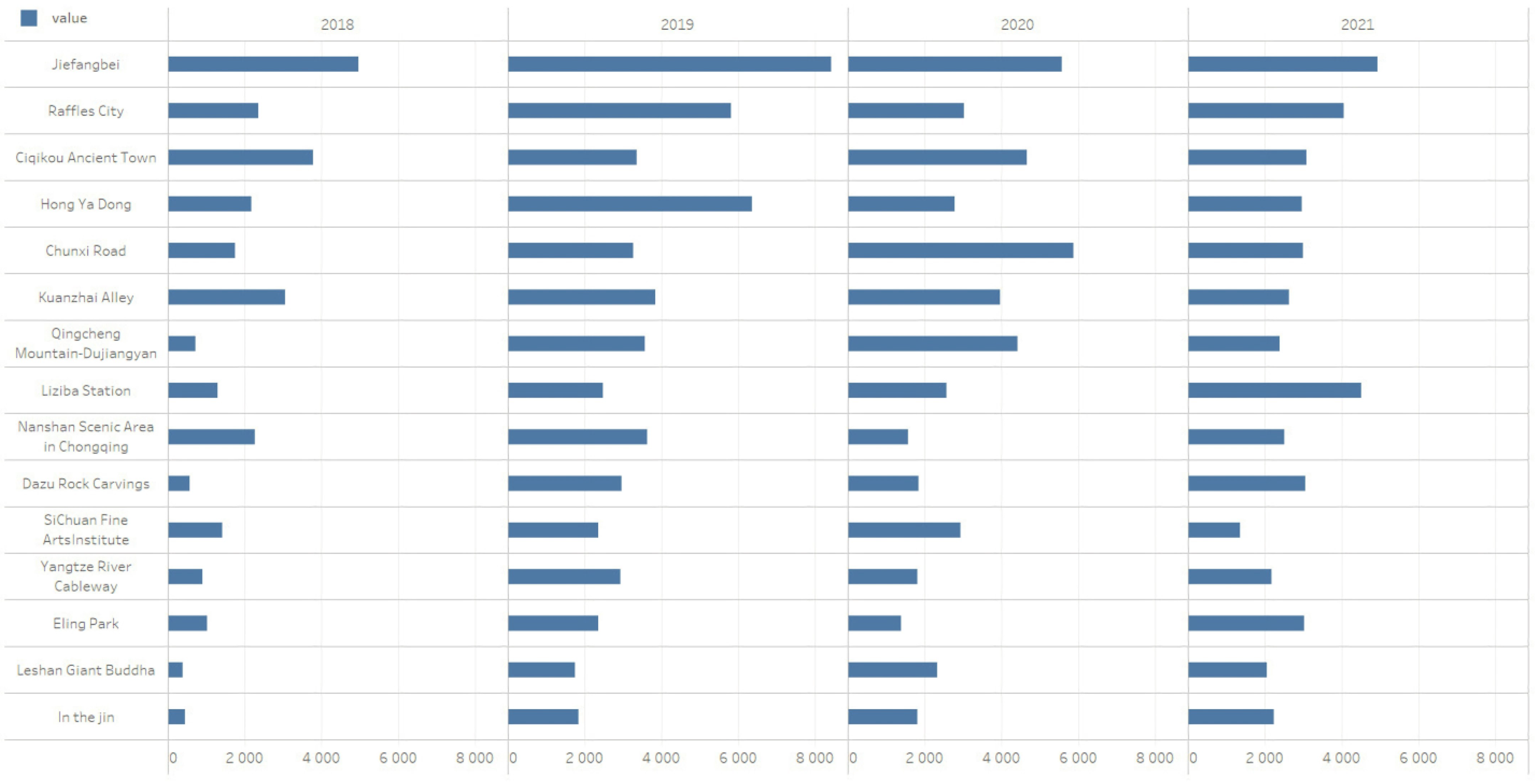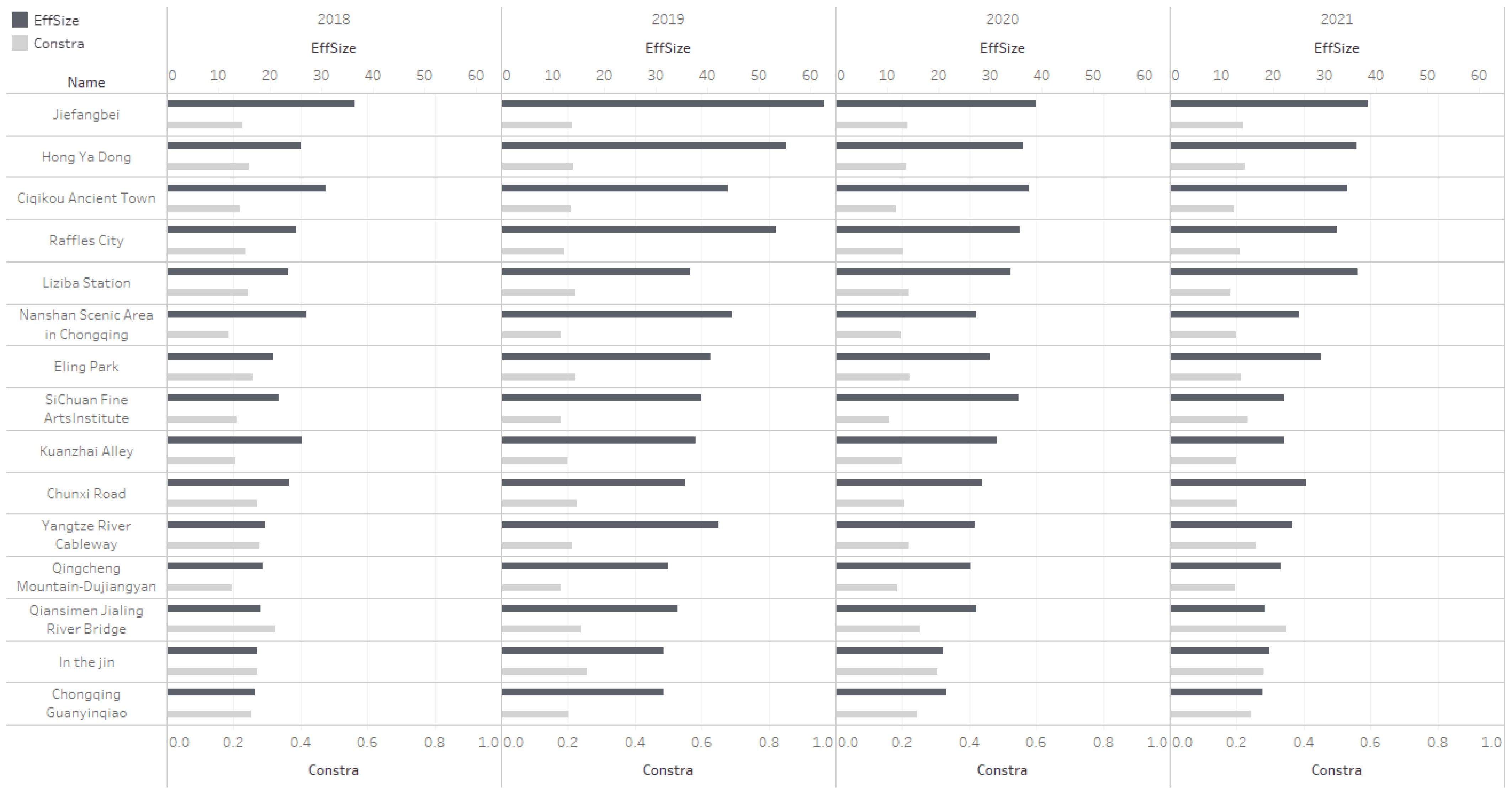Spatial Pattern Evolution and Influencing Factors of Tourism Flow in the Chengdu–Chongqing Economic Circle in China
Abstract
1. Introduction
2. Related Works
3. Study Area, Research Methods and Data Processing
3.1. Study Area
3.2. Research Methods
3.2.1. Social Network Analysis
3.2.2. Weighted Linear Regression
3.3. Data Processing
3.3.1. Data Sources
3.3.2. Data Preprocessing
- (1)
- In the first step, the place names appearing in the original travelogues crawled by Python3.9.6 were counted, and all the place names within the scope of Chengdu–Chongqing Economic Circle were screened out using ArcGIS10.5. In the second step, the original travelogues that did not contain tourism information within the Chengdu–Chongqing Economic Circle were eliminated based on the place names filtered in the first step. In the third step, duplicate travelogues were eliminated, and invalid travelogues, such as commercial propaganda, were screened out. In the fourth step, only travelogues that included two or more scenic spots were retained. After the layers of screening, 1773 travelogues were finally obtained, 281 in 2018, 724 in 2019, 394 in 2020 and 374 in 2021.
- (2)
- In this study, the target area was divided into 44 units based on counties or cities. Based on the above steps, firstly, the Python3.9.6 tool was used to convert the travel time, travel title, travel route and other relevant information in all travel texts into data information stored by Excel. The administrative unit to which each scenic spot belonged was determined using Gaode Map API and manual correction. Secondly, a map of the Chengdu–Chongqing Economic Circle was drawn using ArcGIS10.5, and the longitude and latitude corresponding to the centre point of each administrative unit were found and stored in the Excel database using ArcGIS10.5 surface elements to obtain the centre point. Finally, with the help of Python3.9.6, the number of landscape nodes and administrative unit nodes included in the Tourism Digital Footprint information between 2018 and 2021 was counted. The results showed that 182 landscape areas and 35 units were involved in 2018, 255 landscape areas and 37 units in 2019, 260 landscape areas and 33 units in 2020 and 259 landscape areas and 38 units in 2021.
3.3.3. Data Processing and Analysis
4. Study on the Evolving Characteristics of the Spatial Pattern of Tourism Flows in the Chengdu–Chongqing Economic Circle
4.1. Evolution of the Overall Network Structure of Tourism Flows
4.2. Node Structure Evolution of Tourism Flow Network
4.2.1. Degree Centrality
4.2.2. Closeness Centrality
4.2.3. Betweenness Centrality
4.2.4. Structural Holes
5. Analysis of Influencing Factors of Spatial Pattern Development of Tourism Flow in Chengdu–Chongqing Economic Circle
5.1. Index Selection
5.2. Source and Processing of Original Data
5.3. Regression Results
6. Research Findings and Discussion
6.1. Research Findings
- (1)
- The overall tourism flow network of the Chengdu–Chongqing Economic Circle has a ‘dual core’ structure consisting of Chengdu and Chongqing central city, with Chengdu occupying the main core position in 2018 and Chongqing central city occupying the main core position from 2019 to 2021.
- (2)
- From 2018 to 2021, the overall net density value of tourism flows in the Chengdu–Chongqing Economic Circle was low, and the density distribution was extremely uneven. With the end of 2019 as the turning point, tourism flow’s overall net density value increased and then decreased, with irregular inverted ‘U’ distribution characteristics.
- (3)
- The tourism flow of the Chengdu–Chongqing Economic Circle has ‘two core, four fulcrum’ development advantages. The ‘two cores’ are Chengdu city and the central city of Chongqing, and the ‘four fulcrums’ are Leshan city, Nanchong city, northeast Chongqing and southeast Chongqing.
- (4)
- Kuanzhai Alley, Hong Ya Dong, Chunxi Road, Jiefangbei, Ciqikou Ancient Town, Yangtze River Cableway, Liziba Station and Raffles City ranked in the top 20 in centrality and structural hole measurements in the four years and had irreplaceable competitive advantage in the tourism flow network.
- (5)
- In the administrative unit formed by the city, state, district and county, the node structural hole effectiveness is positively influenced by regional transport accessibility, perfect tourism reception facilities and economic development level. A large number of regional high-quality scenic spots do not bring significant benefits to the tourism industry development of the administrative unit.
6.2. Strategies to Promote Tourism Development in the Chengdu–Chongqing Economic Circle
6.2.1. Making Full Use of the ‘Dual Core’ Advantage to Promote the Simultaneous Development of Several Regions
6.2.2. Reasonable Planning of the Integrated Development Path of Tourism in the Chengdu–Chongqing Economic Circle
6.2.3. Orderly Development of the Tourism Industry under the Normalisation of the Epidemic
6.2.4. Reconstruction of Key Nodes to Help the City Group Maintain Connectivity
6.3. Directions for Further Research
Supplementary Materials
Author Contributions
Funding
Institutional Review Board Statement
Informed Consent Statement
Data Availability Statement
Acknowledgments
Conflicts of Interest
References
- Zhang, H.-L.; Zhuang, M.; Xia, X.-Y.; Liu, S.; Liu, P.-X. Research progress and Prospect of tourism flow in Nanjing University from the perspective of mobility. Mod. Urban Res. 2021, 5, 11–18. [Google Scholar] [CrossRef]
- Boniface, B.; Cooper, C. The Geography of Travel and Tourism; Butterworth Heinemann: Oxford, UK, 1994; pp. 1–6. [Google Scholar] [CrossRef]
- Andraz, J.M.; Rodrigues, P.M.M. Monitoring tourism flows and destination management: Empirical evidence from Portugal. Tour. Manag. 2016, 56, 1–7. [Google Scholar] [CrossRef] [PubMed]
- Provenzano, D. A dynamic analysis of tourism determinants in Sicily. Tour. Econ. 2015, 21, 441–454. [Google Scholar] [CrossRef]
- Lau, P.L.; Koo, T.T.R. Multidimensional decomposition of Gini elasticities to quantify the spatiotemporality of travel and tourism distribution. Tour. Manag. 2022, 88, 104422. [Google Scholar] [CrossRef]
- Narayan, P.K. Economic impact of tourism on Fiji’s economy: Empirical evidence from the computable general equilibrium model. Tour. Econ. 2004, 10, 419–433. [Google Scholar] [CrossRef]
- Salas-Olmedo, M.H.; Moya-Gómez, B.; García-Palomares, J.C.; Gutiérrez, J. Tourists’ digital footprint in cities: Comparing Big Data sources. Tour. Manag. 2018, 66, 13–25. [Google Scholar] [CrossRef]
- Tourism Geography Group, Institute of Geography, Chinese Academy of Sciences (Ed.) Tourism Geography Anthology; Tourism Geography Group, Institute of Geography, Chinese Academy of Sciences: Beijing, China, 1982; ISBN 9787040425994. [Google Scholar]
- Cheng, X.; Wang, K.; Lei, Z.; Luo, M. Evolving characteristics of tourism flow network structure in mountain tourism region: A Case study of Guizhou Province. Resour. Dev. Mark. 2021, 37, 1497–1504. [Google Scholar] [CrossRef]
- Shao, W.-Q.; Xia, Z.-C. Spatial and temporal distribution and influencing factors of tourism flow quality in forest parks in the Yangtze River Economic Belt. J. Yibin Univ. 2022, 22, 10–18. [Google Scholar] [CrossRef]
- Mou, N.; Zheng, Y.; Makkonen, T.; Yang, T.; Tang, J.J.; Song, Y. Tourists’ digital footprint: The spatial patterns of tourist flows in Qingdao, China. Tour. Manag. 2020, 81, 104151. [Google Scholar] [CrossRef]
- Zhao, Y.; Wu, F. The Influence mechanism of tourism on regional economic Disparity: An empirical analysis based on factor flow. Dev. Res. 2013, 5, 66–70. [Google Scholar] [CrossRef]
- Wang, D.; Niu, Y.; Qian, J. Evolution and optimization of China’s urban tourism spatial structure: A high-speed rail perspective. Tour. Manag. 2018, 64, 218–232. [Google Scholar] [CrossRef]
- Liu, Y.; Teng, M.Q. Research on the network structure of night tourism flow based on “tourism digital footprint”: A case study of Guangzhou City. J. Northwest Univ. (Nat. Sci. Ed.) 2021, 51, 279–286. [Google Scholar] [CrossRef]
- Ma, X.; Zhang, Z. Research on Structure Characteristics of tourism flow network in Western Sichuan: Based on Comparative analysis of travel notes of individual travelers and group routes. Areal Res. Dev. 2021, 40, 126–131. [Google Scholar] [CrossRef]
- Gan, C.; Voda, M.; Wang, K.; Chen, L.; Ye, J. Spatial network structure of the tourism economy in urban agglomeration: A social network analysis. J. Hosp. Tour. Manag. 2021, 47, 124–133. [Google Scholar] [CrossRef]
- Yang, G.; Yang, Y.; Gong, G.; Gui, Q. The spatial network structure of tourism efficiency and its influencing factors in China: A social network analysis. Sustainability 2022, 14, 9921. [Google Scholar] [CrossRef]
- Bai, G.; Shen, Y.; Gao, L. Spatial and temporal variation analysis of tourism flows in Guilin based on Weibo data. J. Southwest Univ. (Nat. Sci. Ed.) 2021, 43, 71–80. [Google Scholar] [CrossRef]
- Liu, D.; Chen, J. Research on the spatial and regional differences in the tourism flow network in Chengdu-Chongqing urban agglomeration. J. Southwest Norm. Univ. (Nat. Sci. Ed.) 2020, 45, 112–119. [Google Scholar] [CrossRef]
- Wang, Y.; Lu, Y. The spatial network structure of tourism flow and its influencing factors under continental scale. J. Nat. Sci. Hunan Norm. Univ. 2021, 44, 10–17. [Google Scholar] [CrossRef]
- Li, Q.; Qu, L.Y. Structural characteristics and influencing factors of urban tourism flow network: A case study of Shanghai. World Geogr. Res. 2021, 30, 114–124. [Google Scholar] [CrossRef]
- Li, Q.-P.; Chen, Y.; Luan, X.-C. Analysis of network characteristics of Different types of tourists based on online travel notes: A Case study of Yunnan Province. J. Wuhan Univ. (Inf. Sci. Ed.) 2022, 47, 2143–2152. [Google Scholar] [CrossRef]
- Central Committee of the Communist Party of China and State Council. Outline of the Construction Plan of the Twin-City Economic Circle in the Chengdu–Chongqing Region; Xinhua News Agency: Beijing, China, 2021. [Google Scholar]
- Radcliffe-Brown, A.R. Structure and Function in Primitive Society; The Free Press: Los Angeles, CA, USA, 1952; ISBN 9780710019868. [Google Scholar]
- Burt, R.S. Structural Holes: The Social Structure of Competition; Ren, M., Li, L., Lin, H., Eds.; Gezhi Publishing House: Shanghai, China, 2008; ISBN 9787543214309. [Google Scholar]
- Gonzalez-Diaz, B.; Gomez, M.; Molina, A. Configuration of the hotel and non-hotel accommodations: An empirical approach using network analysis. Int. J. Hosp. Manag. 2015, 48, 39–51. [Google Scholar] [CrossRef]
- Provenzano, D.; Baggio, R. The contribution of human migration to tourism: The VFR travel between the EU 28 member states. Int. J. Tour. Res. 2017, 19, 412–420. [Google Scholar] [CrossRef]
- Provenzano, D.; Hawelka, B.; Baggio, R. The mobility network of European tourists: A longitudinal study and a comparison with geo-located Twitter data. Tour. Rev. 2018, 73, 28–43. [Google Scholar] [CrossRef]
- Šauer, M.; Bobkova, M. Tourist Flows between Central European Metropolises (in the Context of Metropolisation Processes). Geogr. Tech. 2018, 13, 125–137. [Google Scholar] [CrossRef]
- Bendle, L.J. The structures and flows of a large tourist itinerancy network. Curr. Issues Tour. 2018, 21, 103–122. [Google Scholar] [CrossRef]
- Lozano, S.; Gutiérrez, E. A complex network analysis of global tourism flows. Int. J. Tour. Res. 2018, 20, 588–604. [Google Scholar] [CrossRef]
- Chung, M.G.; Herzberger, A.; Frank, K.A.; Liu, J. International tourism dynamics in a globalized world: A social network analysis approach. J. Travel Res. 2020, 59, 387–403. [Google Scholar] [CrossRef]
- Provenzano, D. The migration–tourism nexus in the EU28. Tour. Econ. 2020, 26, 1374–1393. [Google Scholar] [CrossRef]
- Stoddart, M.C.; Catano, G.; Ramos, H.; Vodden, K.; Lowery, B.; Butters, L. Collaboration gaps and regional tourism networks in rural coastal communities. J. Sustain. Tour. 2020, 28, 625–645. [Google Scholar] [CrossRef]
- Park, S.; Zhong, R.; Xu, Y. Understanding seasonal and diurnal variations of inter-city tourism destination network. J. Travel Tour. Mark. 2022, 39, 432–447. [Google Scholar] [CrossRef]
- Scott, J. Social Network Analysis; Liu, J., Ed.; Chongqing University Press: Chongqing, Chuna, 2016; ISBN 9787562496632. [Google Scholar]
- Liu, J. Lecture notes on holistic Network analysis—Application of UCINET software. In Materials of the Second Symposium on Social Networks and Relationship Management; Department of Sociology, Harbin Engineering University: Harbin, China, 2007. [Google Scholar]
- Wang, S.; Dong, Y.Y. Research on structural characteristics of tourism flow network in Henan province based on “tourism digital footprint”. J. Northwest Norm. Univ. (Nat. Sci. Ed.) 2021, 57, 96–103+126. [Google Scholar] [CrossRef]
- Liu, P.; Lu, Y.; Zhang, J.; Zhang, J.; Zhang, H. Travel itinerary patterns and factors affecting tourist flow within destination district. Tour. Trib. 2022, 37, 14–26. [Google Scholar] [CrossRef]










| Indicators | Meaning | Calculation Formula or Realization Path |
|---|---|---|
| Network Density | The ratio of the actual number of relationships present in the trip flow network to the theoretical maximum number of relationships present. | This is achieved through the Network > Ego-networks > Density path of the UCINET6.0 software. |
| Degree Centrality | Measuring the degree to which a tourism node in the network is directly connected to others, inward and outward degree centrality correspond to the node’s ability to cluster and diffuse tourism flows, respectively. | ; is inward degree centrality, is inward degree centrality, indicates that there is a directed link from node to direction, indicates that there is a directed link from node to direction, is the number of travel festival points in the network. |
| Closeness Centrality | Measuring the ability of a tourism node in the network not to be ‘controlled’ by other nodes, there are inward and outward approaches to centrality in a directed tourism network. | ; is the closeness centrality, is the shortest tour line from to . This is the formula for both inward closeness centrality and outward closeness centrality. |
| Betweenness Centrality | Measures the degree of control of tourism flows by tourism nodes in the network. | ; is the betweenness centrality of tourist node , is the number of shortest tour lines from node to and through the node in the network, is the number of shortest tour lines from node to . |
| Structural Holes | Indicates the ability of a node to control the flow of resources in the tourism network and is generally measured by effective size and constraint. | This is achieved through the Network > Ego networks > structural holes path in UCINET6.0 software. |
| 2018 | 2019 | 2020 | 2021 | |
|---|---|---|---|---|
| Tourist Attractions—Overall Net Density | 0.0588 | 0.0720 | 0.0342 | 0.0304 |
| Coefficient | Standard Deviation | t | P > |t| | [0.025 | 0.975] | |
|---|---|---|---|---|---|---|
| x1 | 0.2374 | 0.069 | 3.425 | 0.001 | 0.100 | 0.375 |
| x2 | 0.6779 | 0.118 | 5.749 | 0.000 | 0.444 | 0.911 |
| x3 | −0.0643 | 0.120 | −0.535 | 0.593 | −0.302 | 0.174 |
| x4 | 0.3031 | 0.067 | 4.521 | 0.000 | 0.170 | 0.436 |
| Constant term | 1.041 × 10−17 | 0.062 | 1.68 × 10−16 | 1.000 | −0.122 | 0.122 |
Disclaimer/Publisher’s Note: The statements, opinions and data contained in all publications are solely those of the individual author(s) and contributor(s) and not of MDPI and/or the editor(s). MDPI and/or the editor(s) disclaim responsibility for any injury to people or property resulting from any ideas, methods, instructions or products referred to in the content. |
© 2023 by the authors. Licensee MDPI, Basel, Switzerland. This article is an open access article distributed under the terms and conditions of the Creative Commons Attribution (CC BY) license (https://creativecommons.org/licenses/by/4.0/).
Share and Cite
Chen, X.; Huang, Y.; Chen, Y. Spatial Pattern Evolution and Influencing Factors of Tourism Flow in the Chengdu–Chongqing Economic Circle in China. ISPRS Int. J. Geo-Inf. 2023, 12, 121. https://doi.org/10.3390/ijgi12030121
Chen X, Huang Y, Chen Y. Spatial Pattern Evolution and Influencing Factors of Tourism Flow in the Chengdu–Chongqing Economic Circle in China. ISPRS International Journal of Geo-Information. 2023; 12(3):121. https://doi.org/10.3390/ijgi12030121
Chicago/Turabian StyleChen, Xuejun, Yang Huang, and Yuesheng Chen. 2023. "Spatial Pattern Evolution and Influencing Factors of Tourism Flow in the Chengdu–Chongqing Economic Circle in China" ISPRS International Journal of Geo-Information 12, no. 3: 121. https://doi.org/10.3390/ijgi12030121
APA StyleChen, X., Huang, Y., & Chen, Y. (2023). Spatial Pattern Evolution and Influencing Factors of Tourism Flow in the Chengdu–Chongqing Economic Circle in China. ISPRS International Journal of Geo-Information, 12(3), 121. https://doi.org/10.3390/ijgi12030121





